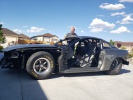I been tuning my car for a few weeks already on 60s and havent figured out the injector offsets. I have them zero'd out and i get a really bad surge on cold starts and on warm starts the car cranks longer to start. I already adjusted my fueling and timing but car still has those small issues. Im thinking it due to the offsets but not sure.
When i had the lsj injectors i used a log of my car running my trifecta tune and used those offsets on my new tune and it worked great. But when i used the same table on the 60s it was running rich even after correcting the MAF. I know if it stays rich that means the numbers in the table are too high and lean means too low.
My question though is how can i calculate the offset tables for these injectors without just inputting different numbers and correcting fuel everytime? Can i log them and then just copy paste? Or is there more involved?




 Reply With Quote
Reply With Quote
